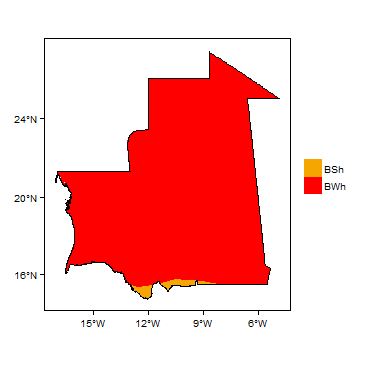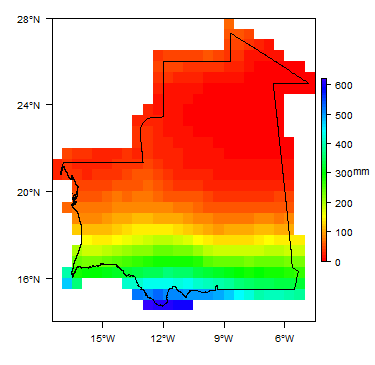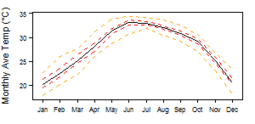Hydrogeology of Mauritania: Difference between revisions
No edit summary |
No edit summary |
||
| Line 154: | Line 154: | ||
The geology maps on this page shows a simplified version of the unconsolidated (superficial) and the bedrock geology of Mauritania at a national scale (see the [[Geology | Geology resource page]] for more details). | The geology maps on this page shows a simplified version of the unconsolidated (superficial) and the bedrock geology of Mauritania at a national scale (see the [[Geology | Geology resource page]] for more details). | ||
More detailed information on the geology of Mauritania is available in the reports [https://pubs.usgs.gov/of/2008/1136/pdf/OF08-1136_508.pdf Friedel and Finn (2008)] and [https://pubs.er.usgs.gov/publication/ofr20131280C Friedel, Finn and Horton (2015)] (see References section, below). | More detailed information on the geology of Mauritania is available in the reports [http://www.geokniga.org/bookfiles/geokniga-geological-atlas-africa.pdf Schlüter (2006)], [https://pubs.usgs.gov/of/2008/1136/pdf/OF08-1136_508.pdf Friedel and Finn (2008)] and [https://pubs.er.usgs.gov/publication/ofr20131280C Friedel, Finn and Horton (2015)] (see References section, below). | ||
| Line 161: | Line 161: | ||
[[File:Mauritania_Geology.png | center | thumb| 500px | Bedrock Geology of Mauritania at 1:5 million scale. Based on map described by Persits et al. 2002 / Furon and Lombard 1964. For more information on the map development and datasets see the [[Geology | geology resource page]].]] | [[File:Mauritania_Geology.png | center | thumb| 500px | Bedrock Geology of Mauritania at 1:5 million scale. Based on map described by Persits et al. 2002 / Furon and Lombard 1964. For more information on the map development and datasets see the [[Geology | geology resource page]].]] | ||
'''Summary''' | |||
Mauritania can be subdivided into four major geological domains (Schlüter 2006): | |||
* the Archean Reguibat Shield in the north; | |||
* the Neoproterozoic NW-SE striking Mauritanide Belt, folded and thrust during the Variscan orogeny; | |||
* the Taoudeni Basin covering most of central and southern Mauritania, with predominantly continental sediments of Neoproterozoic to Phanerozoic age; and | |||
* parts of the Senegal Basin (a 'Continental Terminal' basin) in the southwest, with marine and continental sediments of Jurassic to Recent age, but dominantly of Tertiary-Quaternary age | |||
Sand dunes of the Sahara cover about 50% of Mauritaniaʼs surface. The main areas of these unconsolidated sands are shown in the map of unconsolidated (superficial) geology. The only unconsolidated sediments shown on the bedrock geology map are sediments in the coastal zone, forming a Continental Terminal sequence, part of the Senegal Basin. | |||
| Line 174: | Line 180: | ||
|- | |- | ||
|'Continental Terminal' basin fill | |'Continental Terminal' basin fill | ||
||Marine and continental - including alluvial and lacustrine - sediments that show rapid lateral variation. Lithologies include coarse gravels, fine to shelly to clayey sand, sandstone, caliche and clays. These form part of a coastal sedimentary basin fill sequence, which ranges in thickness from tens of meters at the eastern edge (bounded by Precambrian Basement metamorphic and granitic rocks) to 4 km along the Atlantic coast (Friedel and Finn 2008). | ||Marine and continental - including alluvial and lacustrine - sediments that show rapid lateral variation. Lithologies include coarse gravels, fine to shelly to clayey sand, sandstone, caliche and clays. These form part of a coastal sedimentary basin fill sequence, which ranges in thickness from tens of meters at the eastern edge (bounded by Precambrian Basement metamorphic and granitic rocks) to 4 km along the Atlantic coast (Friedel and Finn 2008). Onshore, the oldest sediments are Late Jurassic marine dolomitic sandstones, overlain by Late Cretaceous to Tertiary continental beds in | ||
the east, interfingering westward with marine sediments deposits (Schlüter 2006). | |||
|- | |- | ||
!colspan="4"| Sedimentary: Cambrian-Tertiary, undifferentiated | !colspan="4"| Sedimentary: Cambrian-Tertiary, undifferentiated (Taoudeni Basin) | ||
|- | |- | ||
| | | | ||
||Below this large area of the country are various Palaeozoic sedimentary bedrock sequences, covered by thick unconsolidated Sahara dune sands and other unconsolidated sediments. Where the bedrock sequences crop out they have been differentiated into older (Cambrian-Carboniferous) and younger (Cretaceous-Tertiary) sedimentary sequences, but below this area they are grouped into a single unit that is likely to include a wide range of different sedimentary rocks. | ||Below this large area of the country are various Palaeozoic sedimentary bedrock sequences, covered by thick unconsolidated Sahara dune sands and other unconsolidated sediments. Where the bedrock sequences crop out they have been differentiated into older (Cambrian-Carboniferous) and younger (Cretaceous-Tertiary) sedimentary sequences, but below this area they are grouped into a single unit that is likely to include a wide range of different sedimentary rocks, both clastic and carbonate. | ||
|- | |- | ||
!colspan="4"| Sedimentary - Cretaceous-Tertiary | !colspan="4"| Sedimentary - Cretaceous-Tertiary (Taoudeni Basin) | ||
|- | |- | ||
| | | | ||
|| | ||Little is known about these rocks. They may be dominated by sandstone. | ||
|- | |- | ||
!colspan="4"| Sedimentary - Cambrian-Carboniferous | !colspan="4"| Sedimentary - Cambrian-Carboniferous (Taoudeni Basin) | ||
|- | |- | ||
|Zemmour Group (Devonian); Tenemouj Group (Devonian-Silurian); L'Oued Chig Group (Silurian); Tichit and Nouatil groups (Ordovician); d'El Harach Group (Cambrian-Ordovician); d’Oujeft Group (Cambrian) | |Zemmour Group (Devonian); Tenemouj Group (Devonian-Silurian); L'Oued Chig Group (Silurian); Tichit and Nouatil groups (Ordovician); d'El Harach Group (Cambrian-Ordovician); d’Oujeft Group (Cambrian) | ||
||Rock types include greywackes, sandstones, limestones, mudstones, siltstones and dolomites. | ||Rock types include greywackes, sandstones, limestones, mudstones, siltstones and dolomites. The oldest rocks include | ||
Cambro-Ordovician fossiliferous marine sandstones, overlain by Late Ordovician tillites, graptolitic Silurian shales and fine sandstones, and Devonian shales with reefal limestones (Schlüter 2006). | |||
|- | |- | ||
!colspan="4"|Igneous | !colspan="4"|Igneous | ||
| Line 199: | Line 207: | ||
|- | |- | ||
|Djonaba, l'Azlaf, Jbéliat, Téniagouri, Aioun, Assabet El Hassiane, Atar, Char, Khaang Naam and El Mreïti groups | |Djonaba, l'Azlaf, Jbéliat, Téniagouri, Aioun, Assabet El Hassiane, Atar, Char, Khaang Naam and El Mreïti groups | ||
||This unit represents a major and varied series of meta-sedimentary rocks, mostly Precambrian in age but the youngest date from the Cambrian period. Rock types include | ||This unit represents a major and varied series of meta-sedimentary rocks, mostly Precambrian in age but the youngest date from the Cambrian period. Rock types include tillites, dolomites, marine cherts and sandstones, conglomerates, pelites, quartzites, schists and limestones. | ||
|- | |- | ||
!colspan="4"| Precambrian Basement | !colspan="4"| Precambrian Basement | ||
| Line 285: | Line 292: | ||
Mohamed A-S et al. 2017. [https://www.sciencedirect.com/science/article/pii/S1631071317301177 Impacts of climate change and anthropization on groundwater resources in the Nouakchott urban area (coastal Mauritania)]. Comptes Rendus Geoscience Vol 389 (6-7), 280-289. Doi: 10.1016/j.crte.2017.09.011 | Mohamed A-S et al. 2017. [https://www.sciencedirect.com/science/article/pii/S1631071317301177 Impacts of climate change and anthropization on groundwater resources in the Nouakchott urban area (coastal Mauritania)]. Comptes Rendus Geoscience Vol 389 (6-7), 280-289. Doi: 10.1016/j.crte.2017.09.011 | ||
Schlüter T. 2006. [http://www.geokniga.org/bookfiles/geokniga-geological-atlas-africa.pdf Geological Atlas of Africa]. Springer Berlin Heidelberg New York | |||
United Nations. 1988. [https://www.bgs.ac.uk/africaGroundwaterAtlas/atlas.cfc?method=ViewDetails&id=AGLA060043 Groundwater in North and West Africa: Mauritania]. United Nations Department of Technical Cooperation for Development and Economic Commission for Africa. | United Nations. 1988. [https://www.bgs.ac.uk/africaGroundwaterAtlas/atlas.cfc?method=ViewDetails&id=AGLA060043 Groundwater in North and West Africa: Mauritania]. United Nations Department of Technical Cooperation for Development and Economic Commission for Africa. | ||
Revision as of 17:02, 1 October 2018
Africa Groundwater Atlas >> Hydrogeology by country >> Hydrogeology of Mauritania
This page is being updated - please check back soon for more content
If you have more information on the hydrogeology of Mauritania, please get in touch.
Much of the area of contemporary Mauritania has been long inhabited by nomadic Berber people, with its south-eastern area falling within the ancient Ghana Empire. From 1000 years ago, successive waves of Arabic invaders dominated the region, beginning with the Almoravid dynasty. From the late 19th century, imperial France began to take over the territories of present-day Mauritania, making it part of French West Africa in 1920. It gained independence as the Islamic Republic of Mauritania in 1960. A one-party state throughout the 1970s and 1980s, the country had a number of military rulers and experienced regime change by military coups, with additional periods of ethnic unrest. After a failed attempt to annex land in the neighbouring Western Sahara, Mauritania withdrew its claims in this regard in 1978. It began to adopt elements of democracy in 1992, with the first fully democratic presidential elections in 2007, but saw further attempted and actual military coups in 2003, 2005 and 2008.
Traditionally, nomadic livelihoods dominated. Severe droughts in the 1970s and 80s led to many people migrating to the coastal cities, but agriculture, particularly livestock, still supports a majority of the population. Iron ore mining accounts for around half of export income. There is also some gold and copper mining. Offshore oil was discovered in 2001, but as yet its future economic influence is uncertain. Ports at the capital city, Nouakchott, and the second city Nouadhibou, are important for the export economy and for the fishing industry.
Mauritania lies almost entirely within the Sahara desert, with very low rainfall, and is very water-poor. Only the coastal zone sees any significant seasonal rainfall. The only perennial river in the country is the Senegal River, which forms its southern border. The country is dependent on groundwater for virtually all its water supply.
Compilers
Dr Kirsty Upton and Brighid Ó Dochartaigh, British Geological Survey, UK
Dr Imogen Bellwood-Howard, Institute of Development Studies, UK
Please cite this page as: Upton, Ó Dochartaigh and Bellwood-Howard, 2018.
Bibliographic reference: Upton K, Ó Dochartaigh BÉ and Bellwood-Howard, I. 2018. Africa Groundwater Atlas: Hydrogeology of Mauritania. British Geological Survey. Accessed [date you accessed the information]. http://earthwise.bgs.ac.uk/index.php/Hydrogeology_of_Mauritania
Terms and conditions
The Africa Groundwater Atlas is hosted by the British Geological Survey (BGS) and includes information from third party sources. Your use of information provided by this website is at your own risk. If reproducing diagrams that include third party information, please cite both the Africa Groundwater Atlas and the third party sources. Please see the Terms of use for more information.
Geographical Setting

General
| Capital city | Nouakchott |
| Region | Western Africa |
| Border countries | Western Sahara, Algeria, Mali, Senegal |
| Total surface area* | 1,030,700 km2 (103,070,000 ha) |
| Total population (2015)* | 4,068,000 |
| Rural population (2015)* | 1,626,000 (40%) |
| Urban population (2015)* | 2,442,000 (60%) |
| UN Human Development Index (HDI) [highest = 1] (2014)* | 0.5059 |
* Source: FAO Aquastat
Climate
More information on average rainfall and temperature for each of the climate zones in Mauritania can be seen at the Mauritania climate page.
These maps and graphs were developed from the CRU TS 3.21 dataset produced by the Climatic Research Unit at the University of East Anglia, UK. For more information see the climate resource page.
Surface water
|
|
 |
Soil
 |
Land cover
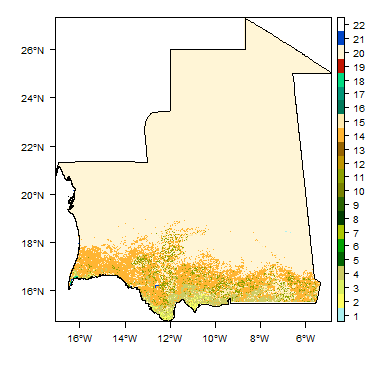 |
Water statistics
| 1994 | 2004 | 2005 | 2012 | 2014 | 2015 | |
| Rural population with access to safe drinking water (%) | 57.1 | |||||
| Urban population with access to safe drinking water (%) | 58.4 | |||||
| Population affected by water related disease | No data | No data | No data | No data | No data | |
| Total internal renewable water resources (cubic metres/inhabitant/year) | 98.33 | |||||
| Total exploitable water resources (Million cubic metres/year) | No data | No data | No data | No data | No data | |
| Freshwater withdrawal as % of total renewable water resources | 11.82 | |||||
| Total renewable groundwater (Million cubic metres/year) | 300 | |||||
| Exploitable: Regular renewable groundwater (Million cubic metres/year) | 880 | |||||
| Groundwater produced internally (Million cubic metres/year) | 300 | |||||
| Fresh groundwater withdrawal (primary and secondary) (Million cubic metres/year) | No data | No data | No data | No data | No data | |
| Groundwater: entering the country (total) (Million cubic metres/year) | No data | No data | No data | No data | No data | |
| Groundwater: leaving the country to other countries (total) (Million cubic metres/year) | No data | No data | No data | No data | No data | |
| Industrial water withdrawal (all water sources) (Million cubic metres/year) | 31.8 | |||||
| Municipal water withdrawal (all water sources) (Million cubic metres/year) | 95.4 | |||||
| Agricultural water withdrawal (all water sources) (Million cubic metres/year) | 1,223 | |||||
| Irrigation water withdrawal (all water sources) 1 (Million cubic metres/year) | 1,223 | |||||
| Irrigation water requirement (all water sources) 1 (Million cubic metres/year) | 374.8 | |||||
| Area of permanent crops (ha) | 11,000 | |||||
| Cultivated land (arable and permanent crops) (ha) | 461,000 | |||||
| Total area of country cultivated (%) | 0.4473 | |||||
| Area equipped for irrigation by groundwater (ha) | 4,751 | |||||
| Area equipped for irrigation by mixed surface water and groundwater (ha) | No data | No data | No data | No data | No data |
These statistics are sourced from FAO Aquastat. They are the most recent available information in the Aquastat database. More information on the derivation and interpretation of these statistics can be seen on the FAO Aquastat website.
Further water and related statistics can be accessed at the Aquastat Main Database.
1 More information on irrigation water use and requirement statistics
Geology
The geology maps on this page shows a simplified version of the unconsolidated (superficial) and the bedrock geology of Mauritania at a national scale (see the Geology resource page for more details).
More detailed information on the geology of Mauritania is available in the reports Schlüter (2006), Friedel and Finn (2008) and Friedel, Finn and Horton (2015) (see References section, below).
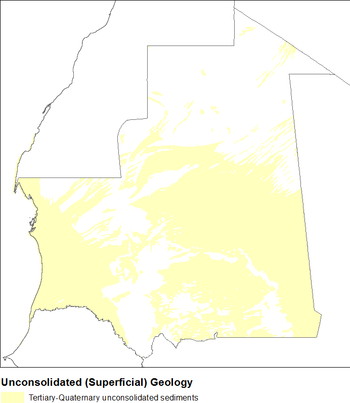
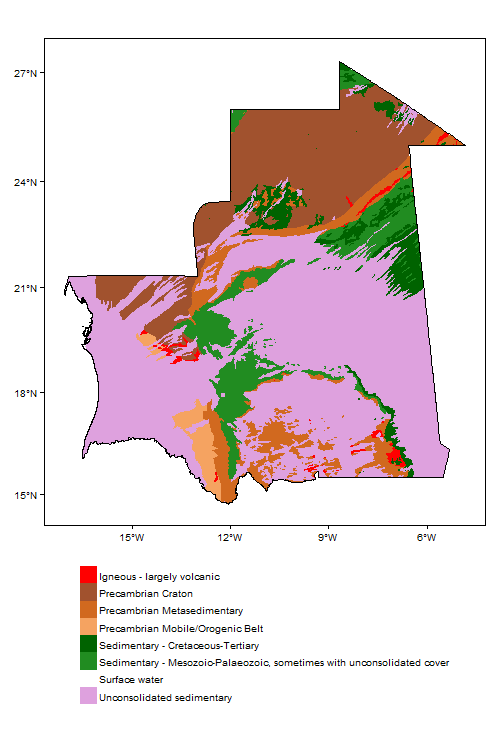
Summary
Mauritania can be subdivided into four major geological domains (Schlüter 2006):
- the Archean Reguibat Shield in the north;
- the Neoproterozoic NW-SE striking Mauritanide Belt, folded and thrust during the Variscan orogeny;
- the Taoudeni Basin covering most of central and southern Mauritania, with predominantly continental sediments of Neoproterozoic to Phanerozoic age; and
- parts of the Senegal Basin (a 'Continental Terminal' basin) in the southwest, with marine and continental sediments of Jurassic to Recent age, but dominantly of Tertiary-Quaternary age
Sand dunes of the Sahara cover about 50% of Mauritaniaʼs surface. The main areas of these unconsolidated sands are shown in the map of unconsolidated (superficial) geology. The only unconsolidated sediments shown on the bedrock geology map are sediments in the coastal zone, forming a Continental Terminal sequence, part of the Senegal Basin.
| Key Formations | Description | ||
| Tertiary-Quaternary unconsolidated sediments | |||
|---|---|---|---|
| 'Continental Terminal' basin fill | Marine and continental - including alluvial and lacustrine - sediments that show rapid lateral variation. Lithologies include coarse gravels, fine to shelly to clayey sand, sandstone, caliche and clays. These form part of a coastal sedimentary basin fill sequence, which ranges in thickness from tens of meters at the eastern edge (bounded by Precambrian Basement metamorphic and granitic rocks) to 4 km along the Atlantic coast (Friedel and Finn 2008). Onshore, the oldest sediments are Late Jurassic marine dolomitic sandstones, overlain by Late Cretaceous to Tertiary continental beds in
the east, interfingering westward with marine sediments deposits (Schlüter 2006). | ||
| Sedimentary: Cambrian-Tertiary, undifferentiated (Taoudeni Basin) | |||
| Below this large area of the country are various Palaeozoic sedimentary bedrock sequences, covered by thick unconsolidated Sahara dune sands and other unconsolidated sediments. Where the bedrock sequences crop out they have been differentiated into older (Cambrian-Carboniferous) and younger (Cretaceous-Tertiary) sedimentary sequences, but below this area they are grouped into a single unit that is likely to include a wide range of different sedimentary rocks, both clastic and carbonate. | |||
| Sedimentary - Cretaceous-Tertiary (Taoudeni Basin) | |||
| Little is known about these rocks. They may be dominated by sandstone. | |||
| Sedimentary - Cambrian-Carboniferous (Taoudeni Basin) | |||
| Zemmour Group (Devonian); Tenemouj Group (Devonian-Silurian); L'Oued Chig Group (Silurian); Tichit and Nouatil groups (Ordovician); d'El Harach Group (Cambrian-Ordovician); d’Oujeft Group (Cambrian) | Rock types include greywackes, sandstones, limestones, mudstones, siltstones and dolomites. The oldest rocks include
Cambro-Ordovician fossiliferous marine sandstones, overlain by Late Ordovician tillites, graptolitic Silurian shales and fine sandstones, and Devonian shales with reefal limestones (Schlüter 2006). | ||
| Igneous | |||
| Igneous rocks cover a very small part of the country. Mostly of Mesozoic and Palaeozoic age. Intrusive Jurassic rocks include dolerite sills and diorites. There are also known rhyolites of Cambrian age (Freidel and Finn 2008). | |||
| Precambrian Metasedimentary | |||
| Djonaba, l'Azlaf, Jbéliat, Téniagouri, Aioun, Assabet El Hassiane, Atar, Char, Khaang Naam and El Mreïti groups | This unit represents a major and varied series of meta-sedimentary rocks, mostly Precambrian in age but the youngest date from the Cambrian period. Rock types include tillites, dolomites, marine cherts and sandstones, conglomerates, pelites, quartzites, schists and limestones. | ||
| Precambrian Basement | |||
| Metamorphic and igneous rocks from the Archaean through Paleoproterozoic to Neoproterozoic eras. In the north of the country, the area of Precambrian basement rocks of known as the Rgueïbat Shield comprises, to the east, a Palaeoproterozoic terrane dominated by metasedimentary rocks, and west of this, an Archean terrane dominated by gneisses and granitic rocks (Friedel and Finn 2008). In the west of the country, immediately to the east of the coastal plain, is a northwest-southeast zone of basement rocks known as the Mauritanide Belt, consisting primarily of trending metamorphic and igneous rocks from the Paleoproterozoic to Neoproterozoic eras. In the northern part, there are schists, metavolcanics, and rhyolites; in
the southern part, there are schists with granitic intrusions (Friedel and Finn 2008). | |||
Hydrogeology
The hydrogeology map on this page shows a simplified overview of the type and productivity of the main aquifers of Mauritania at a national scale (see the Hydrogeology map resource page for more details).
A detailed overview of the hydrogeology of Mauritania is available in the USGS reports Hydrogeology of the Islamic Republic of Mauritania (Friedel and Finn 2008) and Hydrogeologic Map of the Islamic Republic of Mauritania (Friedel, Finn and Horton 2015), which also includes a synthesis of hydrogeological data and a groundwater chemistry map.
Also available to download from the USGS are other outputs from this hydrogeological mapping project, including a GIS shapefile of a geological map categorised into hydrogeological units, and a shapefile of water boreholes/wells with data on static groundwater levels, borehole geology and groundwater conductivity (salinity).
Unconsolidated Aquifers
| Named Aquifers | General Description |
| Trarza | A multilayered unconsolidated aquifer. Groundwater is found preferentially in the higher permeability sandstone, sand and gravel beds, which are separated by lower permeability clays and silts. In Idini there is a shallow unconfined aquifer from 10 - 40 m depth, with TDS ~ 1000 mg/l; a semi-confined aquifer from 60 - 90 m depth with TDS 150 - 400 mg/l; and a deeper aquifer from 150 - 170 m depth with highly mineralised groundwater (TDS 4000 mg/l) (Lacroix and Séméga 2005). By contrast in the Tiguent-Rosso area the aquifer appears dominated by a main unconfined groundwater with occasional saline bodies. |
Consolidated Sedimentary Aquifers - Fracture Flow
| Named Aquifers | General Description |
Consolidated Sedimentary Aquifer - Intergranular & Fracture Flow
| Named Aquifers | General Description |
| ty |
Basement Aquifers
| Named Aquifers | General Description |
Groundwater management
A water point database exists, with entries for nearly 14,000 boreholes and both traditional and modern wells, but has little supporting information (such as geological logs or records of groundwater levels).
Transboundary aquifers
For further information about transboundary aquifers, please see the Transboundary aquifers resources page.
References
The following references provide more information on the hydrogeology and groundwater resources of Mauritania. More references may be available through the Africa Groundwater Literature Archive.
Bertone F et al. 2007. An assessment of the groundwater resources in the westernmargin of the Taoudenni basin, Mauritania. In Chery L and de Marsily G (2007), Aquifer Systems Management: Darcy's Legacy in a World of Impending Water Shortage, IAH Selected Papers on Hydrogeology, Vol. 10, 596pp.
Conrad G and Lappartient J-R. 1987. Le ‘continental terminal’, sa place dans l'évolution géodynamique du bassin sénégalo-mauritanien durant le Cénozoïque. Journal of African Earth Sciences, Vol 6 (1), 45-60. Doi: 10.1016/0899-5362(87)90106-0
Diene M, Kane CH and Sarr D. 2015. Overview of the aquifer system in the Senegalese and Mauritanian sedimentary basin. Revue Cames – Sci. Appl. & de l’Ing., Vol. 1 (2), 86-91. ISSN 2312-8712.
Ebih OMES et al. 2011. Studies on Groundwater in Mauritania. IAEA Water and Environment News, No. 28, 19-20
Friedel MJ and Finn CA. 2008. Hydrogeology of the Islamic Republic of Mauritania. USGS Open-File Report 2008-1136
Friedel MJ, Finn CA and Horton JD. 2015. Hydrogeologic map of the Islamic Republic of Mauritania (phase V, deliverable 56), Synthesis of hydrologic data (phase V, deliverable 57), and chemical hydrologic map of the Islamic Republic of Mauritania (added value): Chapter C in Second projet de renforcement institutionnel du secteur minier de la République Islamique de Mauritanie (PRISM-II). Open-File Report 2013-1280- C. Doi:10.3133/ofr20131280C.
IAEA project webpage. 2015. IAEA project Use of Isotope Hydrology Techniques for the Study of the Trarza’s Aquifer and Discontinued Aquifers in Southern Mauritania.
IAEA. 2017. Integrated and Sustainable Manaagment of Shared Aquifer Systems and Basins of the Sahel region: Senegalo-Mauritanian Basin. Report of the IAEA-Supported Regional Technical Cooperation Project RAF/7/011.
Lacroix M and Séméga B. 2005. Genesis of an endoreic piezometric coastal depression in sub-Sahelian Western Africa: the Continental Terminal Aquifer of Trarza (Mauritania). Geodinamica Acta, Vol 18(5), 389-400. Doi: 10.3166/ga.18.389-400
Mohamed A-S et al. 2017. Impacts of climate change and anthropization on groundwater resources in the Nouakchott urban area (coastal Mauritania). Comptes Rendus Geoscience Vol 389 (6-7), 280-289. Doi: 10.1016/j.crte.2017.09.011
Schlüter T. 2006. Geological Atlas of Africa. Springer Berlin Heidelberg New York
United Nations. 1988. Groundwater in North and West Africa: Mauritania. United Nations Department of Technical Cooperation for Development and Economic Commission for Africa.
World Bank. 1992. Mauritania - Water Supply Project. Memorandum and recommendation of the President of the International Development Association to the Executive Directors on a proposed credit to the amount equivalent to US$10.5 million to the Islamic Republic of Mauritania for a water supply project, May 21 1992.
Return to the index pages
Africa Groundwater Atlas >> Hydrogeology by country >> Hydrogeology of Mauritania
